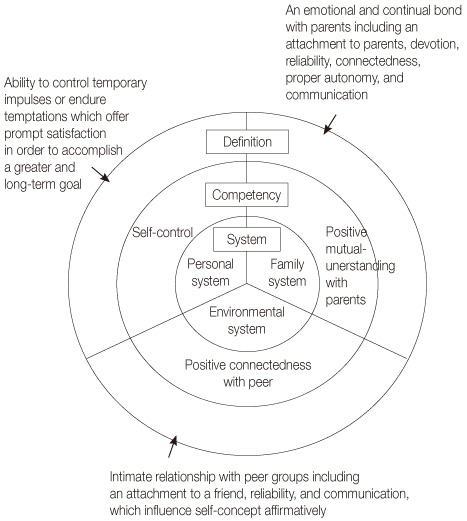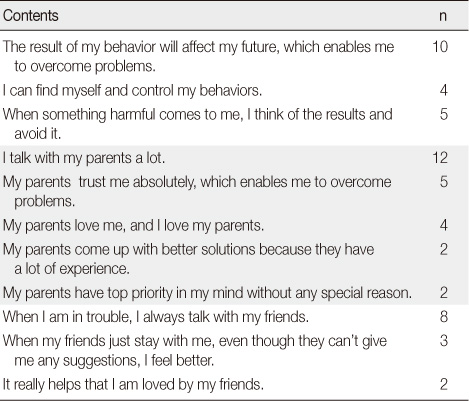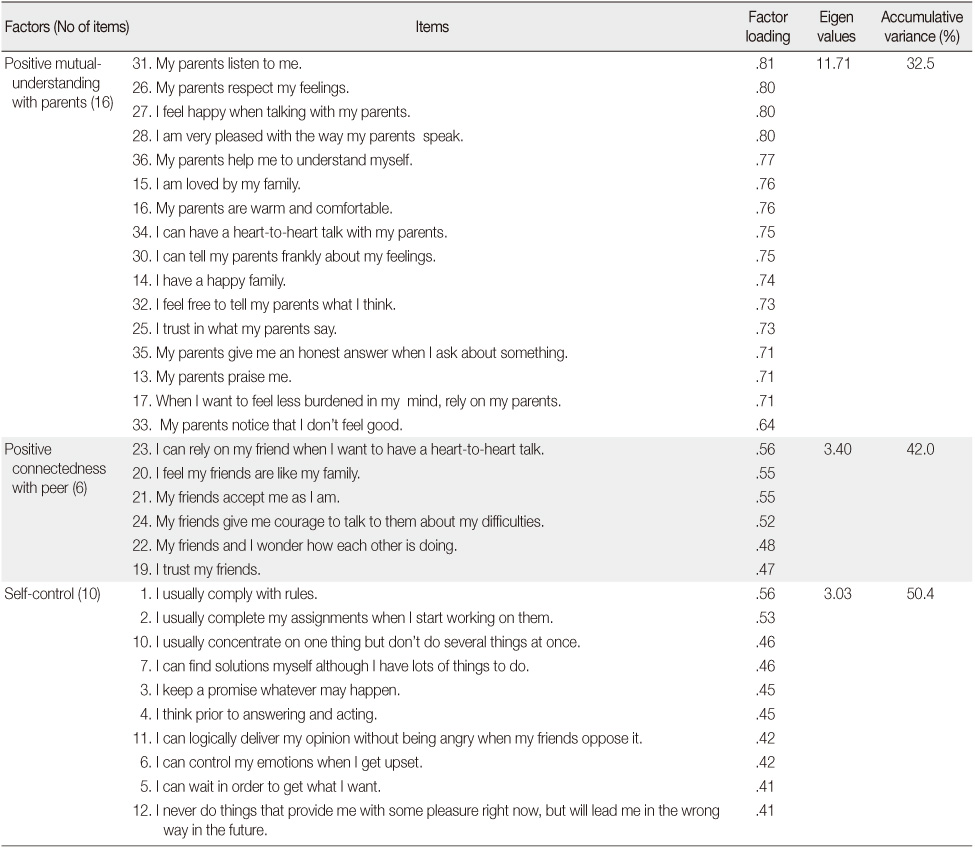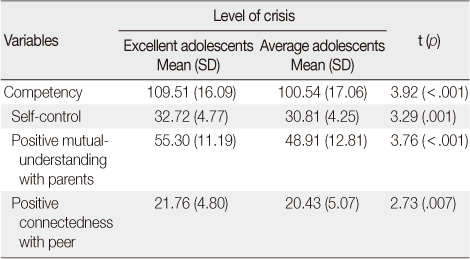Articles
- Page Path
- HOME > J Korean Acad Nurs > Volume 41(2); 2011 > Article
-
Original Article
- Development of the Competency Model for Prevention of Adolescent Risk Behavior
- Hyun Sook Park, Sun Young Jung
-
Journal of Korean Academy of Nursing 2011;41(2):204-213.
DOI: https://doi.org/10.4040/jkan.2011.41.2.204
Published online: April 30, 2011
1Professor, College of Nursing, Catholic University of Daegu, Daegu, Korea.
2Doctoral Student, College of Nursing, Catholic University of Daegu, Daegu, Korea.
- Address reprint requests to: Jung, Sun-Young. College of Nursing, Catholic University of Daegu, 3056-6 Daemyeong 4-dong, Nam-gu, Daegu 705-718, Korea. Tel: +82-10-8952-1646, Fax: +82-53-650-4392, jungsy@cu.ac.kr
• Received: March 6, 2010 • Accepted: April 15, 2011
© 2011 Korean Society of Nursing Science
Abstract
-
Purpose
- This study was done to identify fundamental data on competency reinforcement programs to prevent adolescent risk behavior by developing and examining a competency model.
-
Methods
- In this study, competences on prevention of adolescent risk behavior were identified through competency modeling, and a competency model was developed and tested for validity.
-
Results
- Competences for prevention of adolescent risk behavior defined by the competency model included the following: self-control, positive mutual understanding between parents and adolescents, and positive connectedness with peer group. Validation of the competency model showed the model to be appropriate.
-
Conclusion
- The competency model for prevention of adolescent risk behavior through competency modeling is expected to be the foundation of an integral approach to enhance competency in adolescents and prevent adolescent risk behavior. This kind of approach can be a school-centered, cost-efficient strategy, which not only reduces adolescent risk behavior but also improves quality of adolescent resources.
This research was supported by Basic Science Research Program through the National Research Foundation of Korea (NRF) funded by the Ministry of Education, Science and Technology (NRF-2009-0067064).
- 1. Bronfenbrenner U. Ecological systems theory. Annals of Child Development. 1989;6:185–246.Article
- 2. Calhoun JG, Dollett L, Sinioris ME, Wainio JA, Butler PW, Griffith JR, et al. Development of an interprofessional competency model for healthcare leadership. Journal of Healthcare Management. 2008;53(6):375–390.ArticlePubMed
- 3. Chen AC. What do we know about adolescent risky sexual behavior: A multi-level environmental approach. 2004;University of Washington, Seattle, USA.. Unpublished doctoral dissertation.
- 4. Choi MK, Doh HS. Influences of victimization by peers on the self-esteem of adolescents: The role of attachment and friendship. Korean Journal of Child Studies. 2000;21:85–105.
- 5. Eaton DK, Kann L, Kinchen S, Shanklin S, Ross J, Hawkins J, et al. Youth risk behavior surveillance: United States, 2007. 2008;Vol. 57(No. SS-4):Atlanta, GA, Centers for Disease Control and Prevention.
- 6. Eun Y, Lee IS, Lee KS, Song KJ, Choi EO, Shu SR, et al. The concept analysis of self-control. Journal of Korean Academy of Nursing. 1999;29:951–962.
- 7. Freeman H, Brown BB. Primary attachment to parents and peers during adolescence: Differences by attachment style. Journal of Youth and Adolescence. 2001;30:653–674.ArticlePDF
- 8. Guerra NG, Bradshaw CP. Linking the prevention of problem behaviors and positive youth development: Core competencies for positive youth development and risk prevention. New Directions for Child and Adolescent Development. 2008;122:1–17.
- 9. Guilamo-Ramos V, Litardo H, Jaccard J. Prevention programs for reducing adolescent problem behaviors: Implications of the co-occurrence of problem behaviors in adolescence. Journal of Adolescent Health. 2009;36:82–86.Article
- 10. Hahn JS, Kim SY. A study on the difference in internet activities, self-control, self-regulated learning, and academic achievement according to the level of internet addiction among middle school students. The Journal of Educational Information and Media. 2006;12:161–188.
- 11. Haugaard JJ. Problematic behavior during adolescence. 2001;New York, McGraw-Hill.
- 12. Jeon MI. The mediating effects of social connectedness on the relationships between multidimensional perfectionism and depression, subjective well-being. 2009;Seoul, The Catholic University of Korea. Unpublished master's theses.
- 13. Kim JK. Effect of attachment to parents and peers on risk behaviors and juvenile delinquency among incarcerated teenagers. Korean Journal of Family Welfare. 2008;13:241–255.
- 14. Kim MS. Risk behavior of youth perspectives for lifestyle: Focus on reckless driving. Korean Journal of Youth Studies. 2008;15:301–325.
- 15. Koo BY, Keum MJ. Development of the support model for crisis (possibly) youth. 2005;Seoul, Government Youth Commission.
- 16. Kotchick BA, Shaffer A, Forehand R, Miller KS. Adolescent sexual risk behavior: A multi-system perspective. Clinical Psychology Review. 2001;21:493–519.ArticlePubMed
- 17. Lee DH. Study on the competency modeling and general competencies of a cabin attendant. Korea Journal of Tourism and Hospitality Research. 2006;20:335–350.
- 18. Lee JM, Kwak YS. Clustering of parental and peer variables associated with adolescent risk behaviors and their characteristics: Using mixture model. Korean Journal of Human Ecology. 2007;16:1–10.
- 19. Lipsey MW, Derzon JH. Predictors of violent or serious delinquency in adolescence and early adulthood: A synthesis of longitudinal research. 2007;05;In: Poster session presented at the annual meeting of the Society for Prevention Research; Baltimore, Author.
- 20. Markey CN, Ericksen AJ, Markey PM, Tinsley BJ. Personality and family determinants of preadolescents' participation in health-compromising and health-promoting behaviors. Adolescent and Family Health. 2001;2:83–90.
- 21. Michael LL, Ben-Zur H. Risk taking among adolescents: Association with social and affective factors. Journal of Adolescence. 2007;30:17–31.ArticlePubMedPDF
- 22. Nam KJ, Cho HJ. Development and effect of career planning programs for the female runway teenagers. Journal of Learner-Centered Curriculum and Instruction. 2008;8:125–146.
- 23. Park HS. Validation of path model on adolescents' suicidal ideation and violent behavior. Journal of Korean Academy of Nursing. 2007;37:835–843.PubMed
- 24. Rankin BH, Quane JM. Social context and urban adolescent outcomes: The interrelated effects for neighborhoods, family, and peers on African-American youth. Social Problems. 2002;49:79–100.Article
- 25. Ryu CS. SPSS 14.0 for windows. 2006;5th ed.Seoul, Elite.
- 26. Shim EC. The effective model for parent-adolescents to prevent juvenile delinquency. Journal of Social Sciences. 2005;44:194–205.
- 27. Spencer LM, Spencer SM. Competence at work. 2005;Seoul, PSI Consulting.
- 28. Yu PS. Analysis on effectiveness of the violence prevention program in middle schools. Korean Journal of Youth Studies. 2005;12:51–76.
- 29. Yun MH, Jang AR. A study of life competency for adolescent at risk in Busan area. Pusan Journal of Educational Research. 2007;20:55–79.
REFERENCES
Figure & Data
REFERENCES
Citations
Citations to this article as recorded by 

- Differences in Health Behavior Profiles of Adolescents in Urban and Rural Areas in a Korean City
Myungah Chae, Kihye Han
Healthcare.2021; 9(3): 282. CrossRef - Comparison of characteristics of risk behaviors and injuries between elderly and young population in Korea: application of convergence educational concept
Yang-Ju Tak
Journal of Digital Convergence.2015; 13(5): 289. CrossRef - Construction of the Addiction Prevention Core Competency Model for Preventing Addictive Behavior in Adolescents
Hyun Sook Park, Sun Young Jung
Journal of Korean Academy of Nursing.2013; 43(6): 714. CrossRef - Effects of Competency Model Based Education Program on Risk Behavior and Competences for Preventing Adolescents' Risk Behavior for Adolescents
Hyun Sook Park, Sun Young Jung, Eun Jin Kim
Journal of the Korea Academia-Industrial cooperation Society.2013; 14(4): 1799. CrossRef - Concept Analysis of Health Promotion Competence in Public Health Nurses
Jeong-Soo Kim
Journal of Korean Academy of Community Health Nursing.2011; 22(3): 281. CrossRef
Development of the Competency Model for Prevention of Adolescent Risk Behavior

Figure 1
The competency model for prevention of adolescent risk behavior.
Figure 1
Development of the Competency Model for Prevention of Adolescent Risk Behavior
Content Analysis Behavioral Event Interview
Factor Analysis of Final Items
Competency due to Level of Crisis
Table 1
Content Analysis Behavioral Event Interview
Table 2
Factor Analysis of Final Items
Table 3
Competency due to Level of Crisis
 KSNS
KSNS
 E-SUBMISSION
E-SUBMISSION




 Cite
Cite

